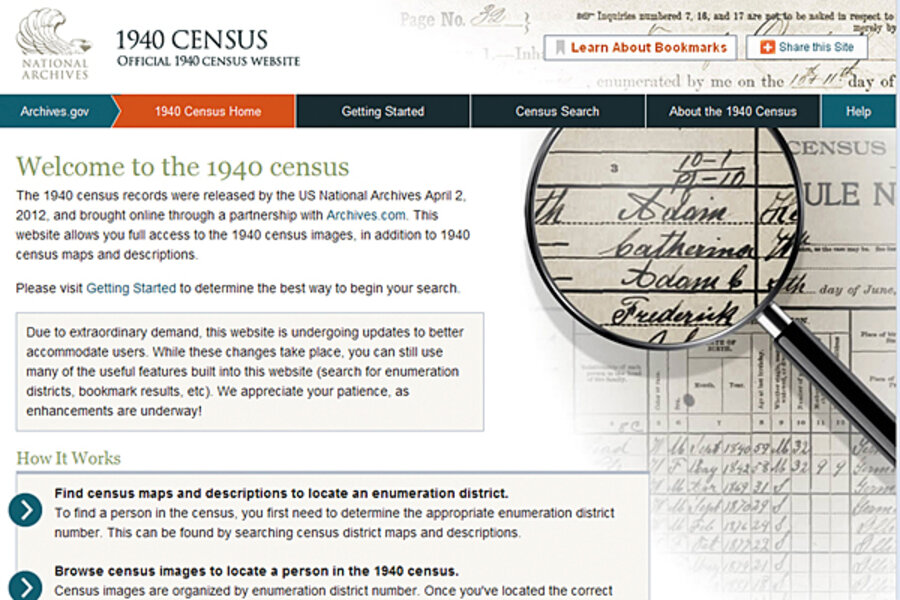1940 Census data: what you need to know to look up relatives
Loading...
| New York
Do you want to know more about your parents or your grandparents? How much money they made, or maybe what they were doing in 1939, when the nation was still trying to recover from the Great Depression?
As it turns out, you would not be alone: On Monday, the US Census Bureau released a trove of personal information it had gleaned from its 1940 Census. For 72 years, the information was considered private. Today, anyone with a computer or a laptop can find out whether their great aunt really did live in a house with a flush toilet or great-grandpa Billy really was a doughboy in World War I.
But, don’t try to find out the information on Monday.
The US Census website is so busy that most computer searches are timing out or not returning results.
According to Google.com, 1940 Census was the most searched term on Monday with some 22.5 million hits in three hours. Even when the US Census officials tried to show off the site to reporters in the morning, they had difficulty getting through. One official from Archives.com joked that he hoped people would use the site but “not all in the next 30 minutes.” He should have said the next 24 hours.
Many of those jumping onto the site were concerned with genealogy.
“I think genealogists have been waiting and drooling over these records being released,” says Stacy Gimbel Vidal, a spokeswoman for the US Census Bureau.
The Census estimates there are still some 21 million people who answered the Census in 1940 who are still alive today.
Initially, those looking for information about their roots will need to know where their relatives lived in 1939. A specific address would help but even a street corner will do. Eventually, some 300,000 volunteers will enter the information into a computer database where it can be searched by individual name.
What those looking up their genealogy will find is such personal information as their relatives' ages, race, marital status, education, and whether they were foreign born. But they will also find whether they had jobs, how much they made, and whether or not they were working for the government. Since 1 in 20 people surveyed were asked supplemental questions, they might also find out where their parents were born, what their mother tongue was, if they were veterans, or if they had a Social Security number. Some were asked if they had been married more than once, the age of their first marriage, and the number of children they had.
All the information was gathered by some 120,000 “enumerators," who methodically went from door to door asking questions.
As David Ferriero, the archivist of the United States, said, it’s a “street-level view.”
For that reason, many historians will also be shifting through the 3.9 million images as well. “Up until now, we had an outline. Now we can look at the individual tiles in the mosaic,” said David Sicilia, a history professor at the University of Maryland, at the Census press conference.
He points out that by looking at the individual data, historians can “explode” myths. For example, the aggregate data may indicate a city or community had only a minor change in population. However, the individual data may show that Americans were moving from city to city in search of jobs.
By culling through the data, Mr. Sicilia says, historians will be able to determine property values, the size and frequency of mortgages, which homes had radios and flush toilets, and even what fuels were used for cooking. Some intrepid researchers may be to determine who were the top “1 percent” of 1939, the year the Census was taken.
But, Sicilia says, the most intriguing information will come from researchers who look at the information in terms what it says about larger groups. For example, historians can look at African Americans to see where they were living, how many were veterans, and how many owned radios. “Let’s get a better understanding of how our forebears experienced the Great Depression – it can only make us wiser,” he says.
Economists have already studied the broader data that was released by the Census in 1943. One of those who became students of the data is Federal Reserve Chairman Ben Bernanke.
“It really does drive his thinking,” says Joel Naroff of Naroff Economic Advisors in New Holland, Pa. One of the lessons Bernanke learned: Even after the Great Depression ended and the economy showed growth from 1933 to 1937, another recession followed. The Census Data shows the toll the downturns took: The unemployment rate was still 15 percent, almost 38 percent of Americans earned under $1,000 a year, and a measurable number of people ages 14 to 15 worked.
“When you were poor then, you were really poor,” says Mr. Naroff.
In the meantime, the top 1 percent of Americans earned $5,000 or more, which was about five times as much as the average American. With the release of the data, some researcher will be able discover who they were.








